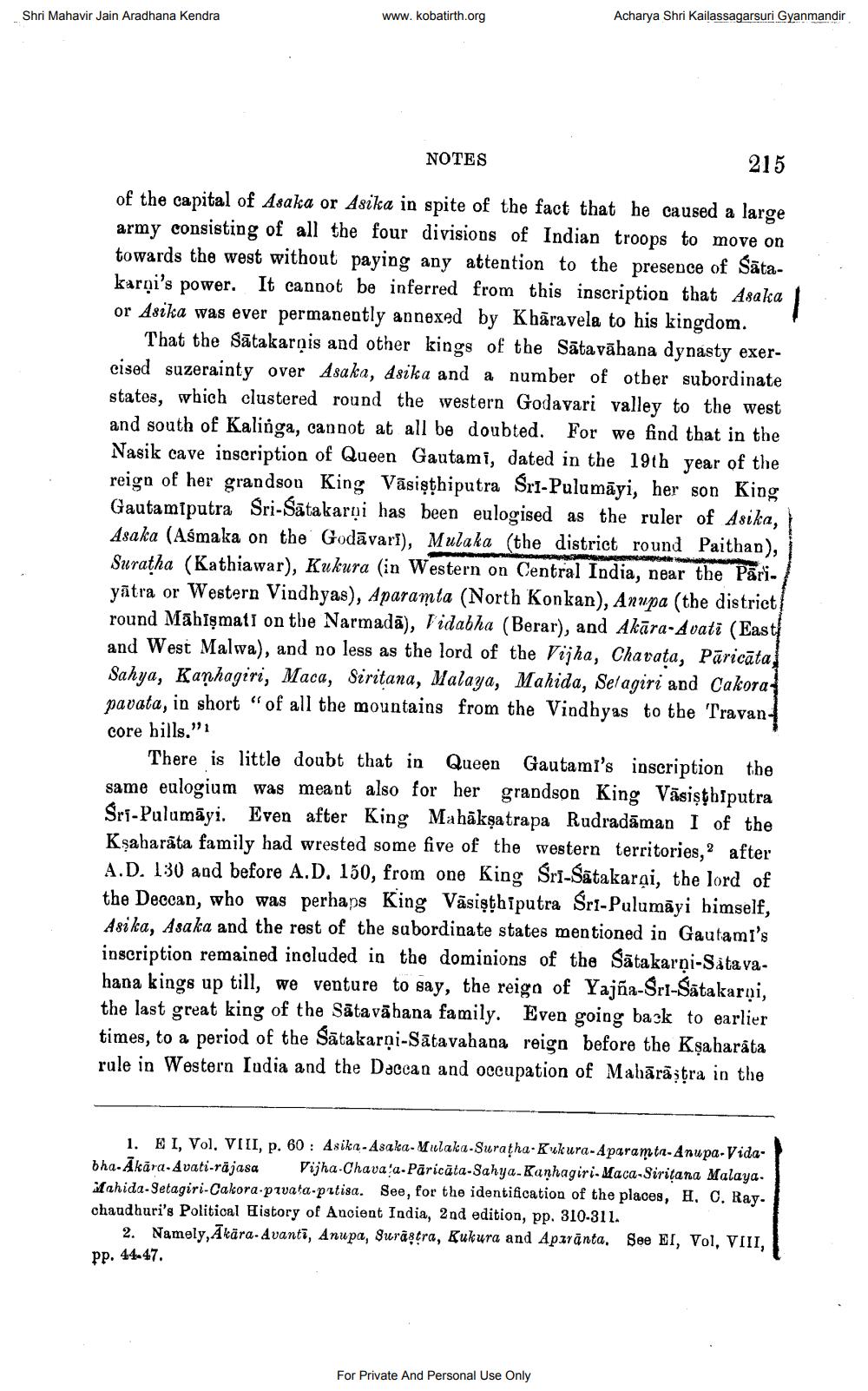________________
Shri Mahavir Jain Aradhana Kendra
Acharya Shri Kailassagarsuri Gyanmandir
www.kobatirth.org
NOTES
215
WARENA
of the capital of Asaka or Asika in spite of the fact that he caused a large army consisting of all the four divisions of Indian troops to move on towards the west without paying any attention to the presence of sātakarņi's power. It cannot be inferred from this inscription that Asaka | or Asika was ever permanently annexed by Khāravela to his kingdom.
That the Sātakarạis and other kings of the Sātavāhana dynasty exercised suzerainty over Asaka, Asika and a number of other subordinate states, which clustered round the western Godavari valley to the west and south of Kalinga, cannot at all be doubted. For we find that in the Nasik cave inscription of Queen Gautami, dated in the 19th year of the reign of her grandson King Vāsişthiputra Sri-Pulumāyi, her son King Gautamiputra Sri-Satakarni has been eulogised as the ruler of Asika, Asaka (Asmaka on the Godāvari), Mulaka (the district round Paithan), Suratha (Kathiawar), Kukura (in Western on Central India, near the Pāriyātra or Western Vindhyas), Aparamta (North Konkan), Anupa (the district round Mahişmati on the Narmadā), Tidabha (Berar), and Akāra-Avati (East and West Malwa), and no less as the lord of the Vijha, Chavata, Pāricāta, Sahya, Kaņhagiri, Maca, Siritana, Malaya, Mahida, Selagiri and Cakora pavata, in short "of all the mountains from the Vindhyas to the Travancore bills."
There is little doubt that in Queen Gautami's inscription the same eulogium was meant also for her grandson King Väsişthiputra Sri-Pulumāyi. Even after King Mahākṣatrapa Rudradāman I of the Ksaharāta family had wrested some five of the western territories, after A.D. 130 and before A.D. 150, from one King Sri-Satakarai, the lord of the Deccan, who was perhaps King Vāsişthiputra Sri-Pulumāyi bimself, Asi ka, Asaka and the rest of the subordinate states mentioned in Gautami's inscription remained included in the dominions of the Satakarņi-Sätavahana kings up till, we venture to say, the reign of Yajña-Sri-Sātakarại, the last great king of the Sātavāhana family. Even going back to earlier times, to a period of the Sātakarņi-Sātavahana reign before the Kșaharāta rule in Western India and the Daccan and occupation of Mahārāztra in the
1. EI, Vol. VIII, p. 60: Asika- Asaka-Mulaka-Suratha-Kukura-Aparamta-Anupa-Vidabha-Ākāra-Avati-räjasa Vijha-Chava'a.Pāricāta-Sahya-Kanhagiri. Maca-Siritana Malaya. ifahida-Setagiri-Cakora prvata prtisa. See, for the identification of the places, H, C. Ray. chaudhuri's Political History of Ancient India, 2nd edition, pp. 310-311.
2. Namely, Ākāra- Avanti, Anupa, Surāştra, Kukura and Apzrānta. See EI, Vol. VIII, pp. 44-47.
For Private And Personal Use Only




